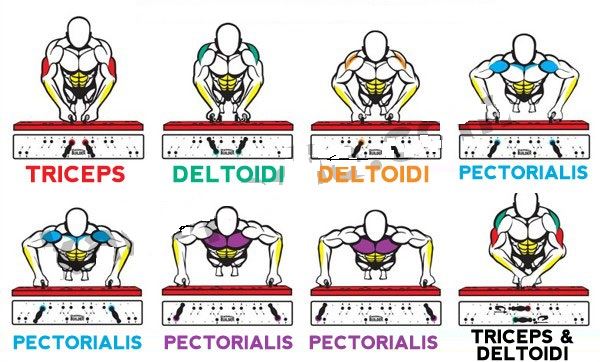Just because regular push-ups became too easy for you doesn’t mean you should throw away one of the most simple yet effective upper-body exercises. Here’s how to make push ups harder.
Even though they may not look as impressive as doing several reps of heavy bench presses, push-ups can still test your ability to produce force in your upper body whilst maintaining a rigid and tight core.
A compound exercise at its core (no pun intended), the push-up stimulates the development of your triceps, pectoral muscles, deltoids, lats, and even the finger-like serratus anterior.
However, if you find yourself doing 50 or more reps in a single go, you may want to consider increasing the difficulty level by using one or more of the methods described below to continue reaping the benefits that this excellent exercise provides.
-
Decline push-up
This is the easiest way to make the push-up harder. All you need to do is elevate your fate on some kind of stable flat surface (like a bench or a box) behind you and do push-ups as usual.
The new angle your body forms with the floor mimics the one it would have on an incline bench press. This will move the stress predominantly to the upper pecs and will require greater engagement from the delts.
The higher you elevate your feet, the more difficult the push-up becomes. If you want to further engage your core, take one foot off of the box.
-
Use it as a finisher
Suppose your record is 100 push-ups in a single go. That would be pretty impressive. But could you do the same number at the end of a 20-set grueling chest workout? Doubtful. Nor should you. Simply do as many as you can as a finishing exercise on a chest day instead of doing more isolation exercises.
By further targeting your triceps and delts with pushups, you will achieve greater muscle tissue breakdown in these muscle groups and you’ll burn more calories.
Try finishing a chest day with 100-150 push-ups, this time doing them in as little time as possible, taking a break whenever necessary.
-
In combination with cardio
Another way to make this upper body exercise more challenging is by doing a set of them after a sprint, a long jog, between rounds of heavy bag punching, or doing anything else besides push-ups.
You can look at this method as kind of a pre-fatigue technique, in which your first exhaust the body with some type of cardio-based activity before doing push-ups.
You can start with a clearly defined goal – let’s say 100 reps – and run half a mile every time you reach failure. If you have to run 3 times or less, increase the rep goal in increments of 25.
To keep things fun, you can pair the push-ups with some other unrelated movements like farmer’s carry, kettlebell swings, or bodyweight squats.
-
With resistance added and explosive technique
If you think any exercise that doesn’t involve iron is useless, then why not just add weight when you’re doing push-ups. How, you ask? Well, the easiest way to achieve that is by using a weighted vest.
There are types of vests that have small packets in which to add tiny weights which will allow you to easily adjust the total weight. That way you can progress in small weight increments. If somehow this isn’t an option for you, you can do plyometric push-ups instead. Try 5 sets of 5 reps, with one-minute rest between sets.
You can also increase the difficulty by performing box-jump push-ups: “jump” with your hands while doing a push-up onto two low boxes positioned just beyond your shoulder width, then “jump” them back down to the floor between the boxes.
-
One-arm push-ups
If you still think there’s nothing more this exercise can offer you, wait until you try the one-arm push-up. It’s highly doubtful you’ll be able to do even one rep, as it’s a very advanced push-up variety. It’s less about strength and more about body awareness and finding balance.
It’s one of those exercises that shows the true superiority of push-ups. There are lots of differing opinions on how to progress on this exercise, but a good place to start is by leaning into a wall and pushing away with one arm at the side.
As you become stronger, move the feet away from the wall. When you find this easy, try it on the edge of a chair or a couch that’s braced against the wall. Then, find something even lower. Finally, you’ll be able to do full reps with one arm on the floor.

